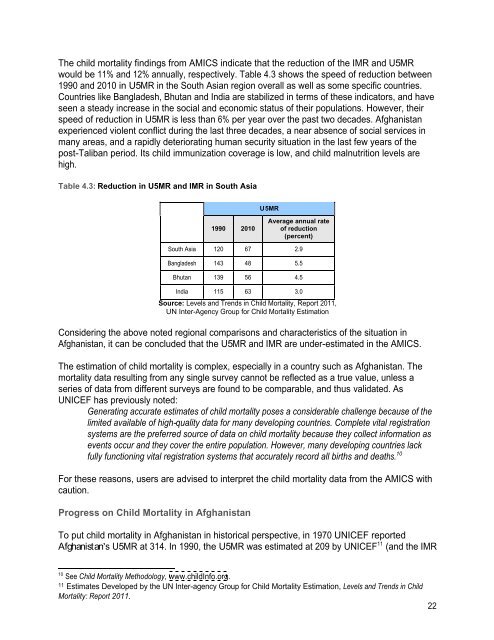Microsoft Word - AMICS-29Jan2013 - Childinfo.org
Microsoft Word - AMICS-29Jan2013 - Childinfo.org
Microsoft Word - AMICS-29Jan2013 - Childinfo.org
Create successful ePaper yourself
Turn your PDF publications into a flip-book with our unique Google optimized e-Paper software.
The child mortality findings from <strong>AMICS</strong> indicate that the reduction of the IMR and U5MR<br />
would be 11% and 12% annually, respectively. Table 4.3 shows the speed of reduction between<br />
1990 and 2010 in U5MR in the South Asian region overall as well as some specific countries.<br />
Countries like Bangladesh, Bhutan and India are stabilized in terms of these indicators, and have<br />
seen a steady increase in the social and economic status of their populations. However, their<br />
speed of reduction in U5MR is less than 6% per year over the past two decades. Afghanistan<br />
experienced violent conflict during the last three decades, a near absence of social services in<br />
many areas, and a rapidly deteriorating human security situation in the last few years of the<br />
post-Taliban period. Its child immunization coverage is low, and child malnutrition levels are<br />
high.<br />
Table 4.3: Reduction in U5MR and IMR in South Asia<br />
U5MR<br />
1990 2010<br />
Average annual rate<br />
of reduction<br />
(percent)<br />
South Asia 120 67 2.9<br />
Bangladesh 143 48 5.5<br />
Bhutan 139 56 4.5<br />
India 115 63 3.0<br />
Source: Levels and Trends in Child Mortality, Report 2011,<br />
UN Inter-Agency Group for Child Mortality Estimation<br />
Considering the above noted regional comparisons and characteristics of the situation in<br />
Afghanistan, it can be concluded that the U5MR and IMR are under-estimated in the <strong>AMICS</strong>.<br />
The estimation of child mortality is complex, especially in a country such as Afghanistan. The<br />
mortality data resulting from any single survey cannot be reflected as a true value, unless a<br />
series of data from different surveys are found to be comparable, and thus validated. As<br />
UNICEF has previously noted:<br />
Generating accurate estimates of child mortality poses a considerable challenge because of the<br />
limited available of high-quality data for many developing countries. Complete vital registration<br />
systems are the preferred source of data on child mortality because they collect information as<br />
events occur and they cover the entire population. However, many developing countries lack<br />
fully functioning vital registration systems that accurately record all births and deaths. 10<br />
For these reasons, users are advised to interpret the child mortality data from the <strong>AMICS</strong> with<br />
caution.<br />
Progress on Child Mortality in Afghanistan<br />
To put child mortality in Afghanistan in historical perspective, in 1970 UNICEF reported<br />
Afghanistan s U5MR at 314. In 1990, the U5MR was estimated at 209 by UNICEF 11 (and the IMR<br />
10<br />
See Child Mortality Methodology, www.childInfo.<strong>org</strong>.<br />
11 Estimates Developed by the UN Inter-agency Group for Child Mortality Estimation, Levels and Trends in Child<br />
Mortality: Report 2011.<br />
22

















